Weihao Xuan
Do Reasoning Models Show Better Verbalized Calibration?
Apr 09, 2025Abstract:Large reasoning models (LRMs) have recently shown impressive capabilities in complex reasoning by leveraging increased test-time computation and exhibiting behaviors akin to human-like deliberation. Despite these advances, it remains an open question whether LRMs are better calibrated - particularly in their verbalized confidence - compared to instruction-tuned counterparts. In this paper, we investigate the calibration properties of LRMs trained via supervised fine-tuning distillation on long reasoning traces (henceforth SFT reasoning models) and outcome-based reinforcement learning for reasoning (henceforth RL reasoning models) across diverse domains. Our findings reveal that LRMs significantly outperform instruction-tuned models on complex reasoning tasks in both accuracy and confidence calibration. In contrast, we find surprising trends in the domain of factuality in particular. On factuality tasks, while Deepseek-R1 shows strong calibration behavior, smaller QwQ-32B shows no improvement over instruct models; moreover, SFT reasoning models display worse calibration (greater overconfidence) compared to instruct models. Our results provide evidence for a potentially critical role of reasoning-oriented RL training in improving LLMs' capacity for generating trustworthy, self-aware outputs.
MMLU-ProX: A Multilingual Benchmark for Advanced Large Language Model Evaluation
Mar 13, 2025Abstract:Traditional benchmarks struggle to evaluate increasingly sophisticated language models in multilingual and culturally diverse contexts. To address this gap, we introduce MMLU-ProX, a comprehensive multilingual benchmark covering 13 typologically diverse languages with approximately 11,829 questions per language. Building on the challenging reasoning-focused design of MMLU-Pro, our framework employs a semi-automatic translation process: translations generated by state-of-the-art large language models (LLMs) are rigorously evaluated by expert annotators to ensure conceptual accuracy, terminological consistency, and cultural relevance. We comprehensively evaluate 25 state-of-the-art LLMs using 5-shot chain-of-thought (CoT) and zero-shot prompting strategies, analyzing their performance across linguistic and cultural boundaries. Our experiments reveal consistent performance degradation from high-resource languages to lower-resource ones, with the best models achieving over 70% accuracy on English but dropping to around 40% for languages like Swahili, highlighting persistent gaps in multilingual capabilities despite recent advances. MMLU-ProX is an ongoing project; we are expanding our benchmark by incorporating additional languages and evaluating more language models to provide a more comprehensive assessment of multilingual capabilities.
BRIGHT: A globally distributed multimodal building damage assessment dataset with very-high-resolution for all-weather disaster response
Jan 10, 2025



Abstract:Disaster events occur around the world and cause significant damage to human life and property. Earth observation (EO) data enables rapid and comprehensive building damage assessment (BDA), an essential capability in the aftermath of a disaster to reduce human casualties and to inform disaster relief efforts. Recent research focuses on the development of AI models to achieve accurate mapping of unseen disaster events, mostly using optical EO data. However, solutions based on optical data are limited to clear skies and daylight hours, preventing a prompt response to disasters. Integrating multimodal (MM) EO data, particularly the combination of optical and SAR imagery, makes it possible to provide all-weather, day-and-night disaster responses. Despite this potential, the development of robust multimodal AI models has been constrained by the lack of suitable benchmark datasets. In this paper, we present a BDA dataset using veRy-hIGH-resoluTion optical and SAR imagery (BRIGHT) to support AI-based all-weather disaster response. To the best of our knowledge, BRIGHT is the first open-access, globally distributed, event-diverse MM dataset specifically curated to support AI-based disaster response. It covers five types of natural disasters and two types of man-made disasters across 12 regions worldwide, with a particular focus on developing countries where external assistance is most needed. The optical and SAR imagery in BRIGHT, with a spatial resolution between 0.3-1 meters, provides detailed representations of individual buildings, making it ideal for precise BDA. In our experiments, we have tested seven advanced AI models trained with our BRIGHT to validate the transferability and robustness. The dataset and code are available at https://github.com/ChenHongruixuan/BRIGHT. BRIGHT also serves as the official dataset for the 2025 IEEE GRSS Data Fusion Contest.
Foundation Models for Remote Sensing and Earth Observation: A Survey
Oct 22, 2024Abstract:Remote Sensing (RS) is a crucial technology for observing, monitoring, and interpreting our planet, with broad applications across geoscience, economics, humanitarian fields, etc. While artificial intelligence (AI), particularly deep learning, has achieved significant advances in RS, unique challenges persist in developing more intelligent RS systems, including the complexity of Earth's environments, diverse sensor modalities, distinctive feature patterns, varying spatial and spectral resolutions, and temporal dynamics. Meanwhile, recent breakthroughs in large Foundation Models (FMs) have expanded AI's potential across many domains due to their exceptional generalizability and zero-shot transfer capabilities. However, their success has largely been confined to natural data like images and video, with degraded performance and even failures for RS data of various non-optical modalities. This has inspired growing interest in developing Remote Sensing Foundation Models (RSFMs) to address the complex demands of Earth Observation (EO) tasks, spanning the surface, atmosphere, and oceans. This survey systematically reviews the emerging field of RSFMs. It begins with an outline of their motivation and background, followed by an introduction of their foundational concepts. It then categorizes and reviews existing RSFM studies including their datasets and technical contributions across Visual Foundation Models (VFMs), Visual-Language Models (VLMs), Large Language Models (LLMs), and beyond. In addition, we benchmark these models against publicly available datasets, discuss existing challenges, and propose future research directions in this rapidly evolving field.
Segment Anything with Multiple Modalities
Aug 17, 2024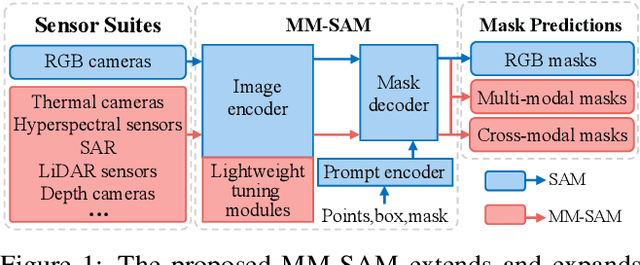



Abstract:Robust and accurate segmentation of scenes has become one core functionality in various visual recognition and navigation tasks. This has inspired the recent development of Segment Anything Model (SAM), a foundation model for general mask segmentation. However, SAM is largely tailored for single-modal RGB images, limiting its applicability to multi-modal data captured with widely-adopted sensor suites, such as LiDAR plus RGB, depth plus RGB, thermal plus RGB, etc. We develop MM-SAM, an extension and expansion of SAM that supports cross-modal and multi-modal processing for robust and enhanced segmentation with different sensor suites. MM-SAM features two key designs, namely, unsupervised cross-modal transfer and weakly-supervised multi-modal fusion, enabling label-efficient and parameter-efficient adaptation toward various sensor modalities. It addresses three main challenges: 1) adaptation toward diverse non-RGB sensors for single-modal processing, 2) synergistic processing of multi-modal data via sensor fusion, and 3) mask-free training for different downstream tasks. Extensive experiments show that MM-SAM consistently outperforms SAM by large margins, demonstrating its effectiveness and robustness across various sensors and data modalities.
SynRS3D: A Synthetic Dataset for Global 3D Semantic Understanding from Monocular Remote Sensing Imagery
Jun 26, 2024



Abstract:Global semantic 3D understanding from single-view high-resolution remote sensing (RS) imagery is crucial for Earth Observation (EO). However, this task faces significant challenges due to the high costs of annotations and data collection, as well as geographically restricted data availability. To address these challenges, synthetic data offer a promising solution by being easily accessible and thus enabling the provision of large and diverse datasets. We develop a specialized synthetic data generation pipeline for EO and introduce SynRS3D, the largest synthetic RS 3D dataset. SynRS3D comprises 69,667 high-resolution optical images that cover six different city styles worldwide and feature eight land cover types, precise height information, and building change masks. To further enhance its utility, we develop a novel multi-task unsupervised domain adaptation (UDA) method, RS3DAda, coupled with our synthetic dataset, which facilitates the RS-specific transition from synthetic to real scenarios for land cover mapping and height estimation tasks, ultimately enabling global monocular 3D semantic understanding based on synthetic data. Extensive experiments on various real-world datasets demonstrate the adaptability and effectiveness of our synthetic dataset and proposed RS3DAda method. SynRS3D and related codes will be available.
CAT-SAM: Conditional Tuning Network for Few-Shot Adaptation of Segmentation Anything Model
Feb 06, 2024


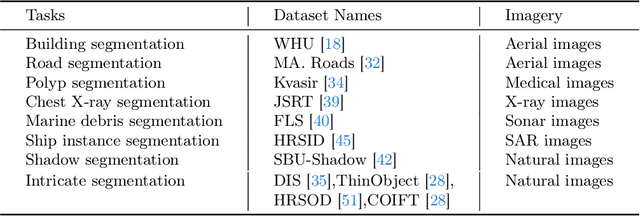
Abstract:The recent Segment Anything Model (SAM) has demonstrated remarkable zero-shot capability and flexible geometric prompting in general image segmentation. However, SAM often struggles when handling various unconventional images, such as aerial, medical, and non-RGB images. This paper presents CAT-SAM, a ConditionAl Tuning network that adapts SAM toward various unconventional target tasks with just few-shot target samples. CAT-SAM freezes the entire SAM and adapts its mask decoder and image encoder simultaneously with a small number of learnable parameters. The core design is a prompt bridge structure that enables decoder-conditioned joint tuning of the heavyweight image encoder and the lightweight mask decoder. The bridging maps the prompt token of the mask decoder to the image encoder, fostering synergic adaptation of the encoder and the decoder with mutual benefits. We develop two representative tuning strategies for the image encoder which leads to two CAT-SAM variants: one injecting learnable prompt tokens in the input space and the other inserting lightweight adapter networks. Extensive experiments over 11 unconventional tasks show that both CAT-SAM variants achieve superior target segmentation performance consistently even under the very challenging one-shot adaptation setup. Project page: \url{https://xiaoaoran.github.io/projects/CAT-SAM}
3D Semantic Segmentation in the Wild: Learning Generalized Models for Adverse-Condition Point Clouds
Apr 03, 2023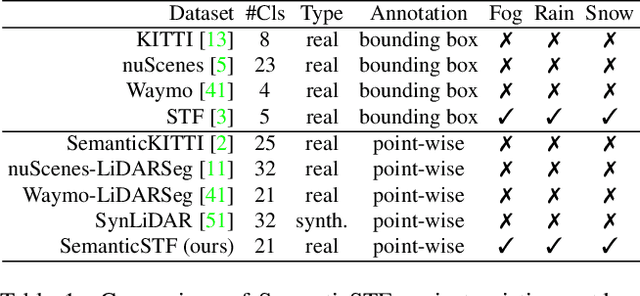

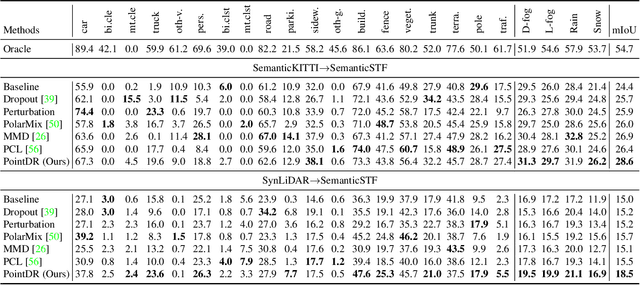
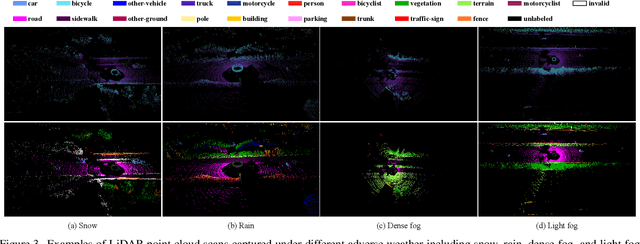
Abstract:Robust point cloud parsing under all-weather conditions is crucial to level-5 autonomy in autonomous driving. However, how to learn a universal 3D semantic segmentation (3DSS) model is largely neglected as most existing benchmarks are dominated by point clouds captured under normal weather. We introduce SemanticSTF, an adverse-weather point cloud dataset that provides dense point-level annotations and allows to study 3DSS under various adverse weather conditions. We study all-weather 3DSS modeling under two setups: 1) domain adaptive 3DSS that adapts from normal-weather data to adverse-weather data; 2) domain generalizable 3DSS that learns all-weather 3DSS models from normal-weather data. Our studies reveal the challenge while existing 3DSS methods encounter adverse-weather data, showing the great value of SemanticSTF in steering the future endeavor along this very meaningful research direction. In addition, we design a domain randomization technique that alternatively randomizes the geometry styles of point clouds and aggregates their embeddings, ultimately leading to a generalizable model that can improve 3DSS under various adverse weather effectively. The SemanticSTF and related codes are available at \url{https://github.com/xiaoaoran/SemanticSTF}.
Multi-agent Interactive Prediction under Challenging Driving Scenarios
Sep 24, 2019



Abstract:In order to drive safely on the road, autonomous vehicle is expected to predict future outcomes of its surrounding environment and react properly. In fact, many researchers have been focused on solving behavioral prediction problems for autonomous vehicles. However, very few of them consider multi-agent prediction under challenging driving scenarios such as urban environment. In this paper, we proposed a prediction method that is able to predict various complicated driving scenarios where heterogeneous road entities, signal lights, and static map information are taken into account. Moreover, the proposed multi-agent interactive prediction (MAIP) system is capable of simultaneously predicting any number of road entities while considering their mutual interactions. A case study of a simulated challenging urban intersection scenario is provided to demonstrate the performance and capability of the proposed prediction system.
 Add to Chrome
Add to Chrome Add to Firefox
Add to Firefox Add to Edge
Add to Edge